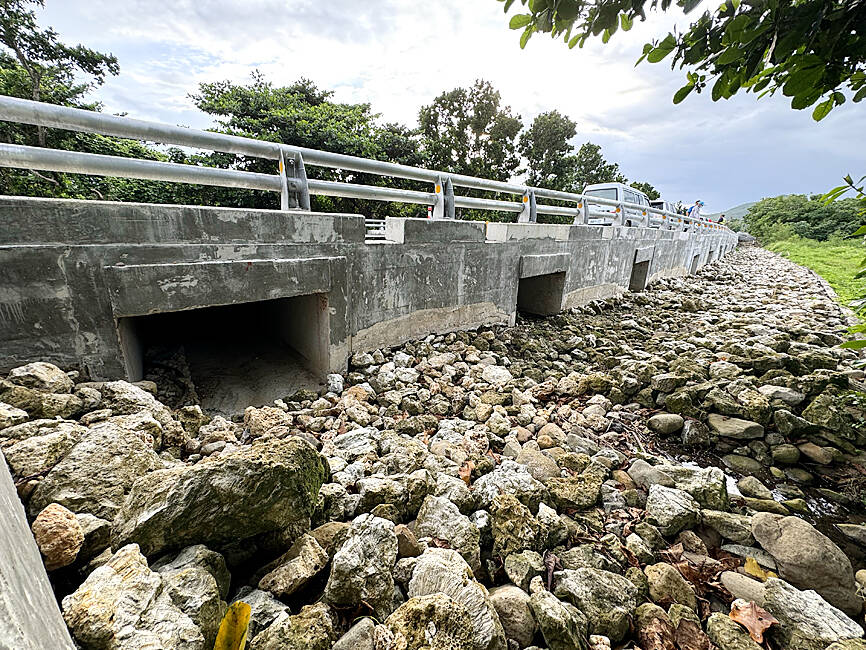The Highway Bureau yesterday said that wildlife crossings built along Highway 26 have helped reduce land crab deaths caused by vehicles by 81 percent, but experts said more needs to be done to protect the species.
Since 2008, the bureau has restricted access to the highway’s Banana Bay (香蕉灣) section on certain days of the year, given its proximity to the natural habitat of land crabs.
At one point 62 different land crabs were recorded in the area, accounting for 95 percent of the species found in Taiwan, studies showed.

Photo: Tsai Yun-jung, Taipei Times
Taiwan’s land crab population has declined 95 percent in the past 30 years due to urban expansion, invasive foreign species, excessive capturing by humans and their migratory routes during the spawning season being cut off by roads, the bureau said.
Although land crabs spend most of their lives on land, female land crabs must annually migrate to the sea to release their larvae. Land crabs living around Banana Bay must cross Highway 26 before reaching the sea.
A study conducted by Taiwan Academy of Ecology chairman Liu Hung-chang (劉烘昌) from June 2019 to Aug. 31, 2019, showed that as many as 240 land crabs could be killed within the Banana Bay section.
The bureau in 2008 launched efforts to protect land crabs by reducing the number of accessible traffic lanes in the section from 6:30pm to 8:30pm on certain days during the spawning season. In 2017, hemp ropes and wooden bars were installed in drainage culverts to help land crabs cross the highway.
Last year, the bureau further elevated the height of the highway and installed 36 more culverts that function as wildlife crossings. This year, the bureau placed coral stones and driftwood to guide land crabs to access the passages.
The additional culverts installed last year have proven to be effective, as they reduced the road mortality rate of land crabs in the section by 81 percent, the bureau’s South Region Branch Office Director Chen Kuei-fang (陳貴芳) said.
The bureau was set to control traffic at the Banana Bay section in three time periods, including from 6:30pm to 8:30pm from July 20 to 22 and Sunday to today, as well as from 6pm to 8pm from Sept. 17 to 19.
During the traffic control periods, the accessible traffic lanes at the Banana Bay section would be reduced to two from four. The lanes would be opened for 10 minutes for every 10 minutes they are closed, the bureau said.
Volunteers would use the time to study and record the number of land crabs crossing the section and bring them to the seashore, the bureau said.
On Sunday, volunteers used captured female crabs to show how they walk to sea to release larvae.
Liu told reporters in a presentation on the site that wildlife crossings cannot completely protect land crabs from being killed by drivers.
“The fundamental issue is that land crabs live in spring zones behind the residential area. They are pretty stubborn and would insist on going in the direction that they believe would lead them to the sea,” he said.
“When it is time to release larvae, they are more likely to migrate through routes near the residential area. Our wildlife crossings are not always in the proximity of residential areas. As such, most of the land crabs still migrate at routes north of culverts. More needs to be done to protect them,” Liu said.

Global bodies should stop excluding Taiwan for political reasons, President William Lai (賴清德) told Pope Francis in a letter, adding that he agrees war has no winners. The Vatican is one of only 12 countries to retain formal diplomatic ties with Taiwan, and Taipei has watched with concern efforts by Beijing and the Holy See to improve ties. In October, the Vatican and China extended an accord on the appointment of Catholic bishops in China for four years, pointing to a new level of trust between the two parties. Lai, writing to the pope in response to the pontiff’s message on Jan. 1’s

A Vietnamese migrant worker on Thursday won the NT$12 million (US$383,590) jackpot on a scratch-off lottery ticket she bought from a lottery shop in Changhua County’s Puyan Township (埔鹽), Taiwan Lottery Co said yesterday. The lottery winner, who is in her 30s and married, said she would continue to work in Taiwan and send her winnings to her family in Vietnam to improve their life. More Taiwanese and migrant workers have flocked to the lottery shop on Sec 2 of Jhangshuei Road (彰水路) to share in the luck. The shop owner, surnamed Chen (陳), said that his shop has been open for just

HOLIDAY EXERCISE: National forest recreation areas from north to south offer travelers a wide choice of sights to connect with nature and enjoy its benefits Hiking is a good way to improve one’s health, the Forestry and Nature Conservation Agency said, as it released a list of national forest recreation areas that travelers can visit during the Lunar New Year holiday. Taking a green shower of phytoncides in the woods could boost one’s immunity system and metabolism, agency Director-General Lin Hwa-ching (林華慶) cited a Japanese study as saying. For people visiting northern Taiwan, Lin recommended the Dongyanshan National Forest Recreation Area in Taoyuan’s Fusing District (復興). Once an important plantation in the north, Dongyanshan (東眼山) has a number of historic monuments, he said. The area is broadly covered by

Tainan’s initiative to recruit digital nomads has resulted in several German, US and Vietnamese nationals applying to live and work in the city, the Tainan Research, Development and Evaluation Commission said yesterday. That marked the city as the first in the nation to attract digital nomads, following the launch of the program last month, it said. Although all applicants so far have used work visas or tourism visas instead of the special digital nomad permit from the Ministry of Foreign Affairs, the city government believes that the latter would be needed eventually, the commission said. The digital nomads recruited by Tainan would work